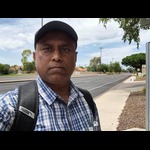Bangladesh '24 feels like a mirror image of East Pakistan '71

Dhaka felt like a beseized city with violence on the street; Photo Credit: Nazmul Islam
Bangladesh felt like a besieged country and Dhaka seemed like a city of terror.
The situation was similar to how it was in 1971. The streets were patrolled by the army, and curfews were frequent. People were unsafe both inside and outside their homes.
At that time, we had decided that if we were to die, we would die in our own country; we would not go to India.
For a safe refuge, my father rented a small house in a narrow alley beside the Fakirapool water tank in Dhaka. Our family of four lived there. At any moment, bullets could come from any direction.
Everyone would paste pieces of paper on the glass windows with glue. It was believed that these paper pieces might offer some resistance against the sudden incoming bullets.
Whenever the sirens sounded, air raids would begin. Bomber planes would arrive within seconds, and the bombing would start. The deafening noise would terrify us.
Thick black smoke would rise from the areas being bombed. Our building was three stories high. Since we lived on the ground floor, everyone in the building would come to our apartment when the bombing started.
There wasn’t enough space for everyone in the small apartment, so some people would stand on the roof of the building to watch the aerial battles. There were dogfights between planes, and sometimes anti-aircraft guns would shoot down planes.
The pilots would parachute down. They would watch these scenes and say there was nothing to be afraid of, as most of the planes were Indian.
Then I heard that an attack would be launched on Dhaka that would destroy everything up to two inches below the surface.
Everyone was advised to leave Dhaka. A house was rented for us in Jinjira, across the Buriganga River. Eventually, the decision was made to stay here. Although I’m not sure if we could have managed it, we heard that even if one tried to cross the river, they would be shot at.
The situation in Dhaka now seems similar. The police and military have taken positions on the streets. When curfews are relaxed, people venture out to carry out daily tasks.
Everyone is fearful. Everyone supports the movement but cannot express it openly. People are afraid to even talk on the telephone. Sheikh Hasina seems like Tikka Khan. The student league has taken the place of Al-Badr and Razakars.
With police protection, they are terrorizing the streets. The elderly freedom fighters of '71 seem like members of the Peace Committee, providing silent support to the government. Meanwhile, the so-called human rights activists seem to have disappeared.
No one is taking steps to resolve the issues. The people of Bangladesh are no longer safe even in their own homes. Many children and teenagers have lost their lives on the rooftops of their houses.
Sheikh Mujibur Rahman led the independence movement and was killed in 1975. Since then, his daughter has been governing the country for 21 (16 years in a row) years. Yet, the greed for her power persists and the desire to make power permanent remains.
Just as the Pakistani military government of 1971 did not hesitate to kill people, the Awami League government does not either.
The police, military, and student league have all been mobilized. Sheikh Hasina has adopted a stance similar to that of Yahya Khan, being hostile to the people. She labels unarmed protesters as criminals.
People are dying, and she seems indifferent to it. Her aim is to make her power eternal.
Fifty years after independence, the people of Bangladesh are witnessing another bloody chapter. Everything seems just like in 1971, only the ruling party has changed. And now they speak in "Bangla."
—
CM Kajawl is a U.S based journalist and commentator

